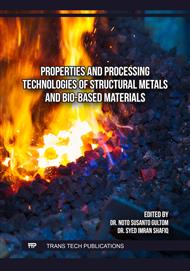[1]
Information on https://www.archive.bps.go.id/indicator/55/61/6/produksi-tanaman-sayuran.html
Google Scholar
[2]
N. Mpumi, R.S. Machunda, K.M. Mtei and P.A. Ndakidemi, Selected insect pests of economic importance to Brassica oleracea, their control strategies and the potential threat to environmental pollution in Africa. Sustainability. 12 (2020) 1–22.
DOI: 10.3390/su12093824
Google Scholar
[3]
A.D. Permana, S. Marlinda, A. Susanto and A.S. Leksono, Effectiveness of Cordyceps sp. and Beauveria bassiana against large cabbage-heart caterpillar, Crocidolomia pavonana Fabricius (Lepidoptera: Crambidae). Int. J. Biol. Eng. 16 (2022) 14–18.
DOI: 10.46300/91011.2022.16.3
Google Scholar
[4]
P.S. Nenotek, J.A. Londingkene, R. Ludji, T.S. Harini, M.J. Kapa, E.S.O. Nguru, E. Roefaida and M. Konanin, The toxicity of Annona squamosa seeds and Anacardium occidentale seed shells from East Nusa Tenggara, Indonesia, against cabbage caterpillar (Crocidolomia pavonana). Intl.J.Trop. Drylands. 6 (2022) 39-44.
DOI: 10.13057/tropdrylands/t060105
Google Scholar
[5]
J. Kumar, A. Ramlal, D. Mallick and V. Mishra, An overview of some biopesticides and their importance in plant protection for commercial acceptance. Plants. 10 (2021) 1–15.
DOI: 10.3390/plants10061185
Google Scholar
[6]
K.D. Singh, A.J. Mobolade, R. Bharali, D. Sahoo and Y. Rajashekar, Main plant volatiles as stored grain pest management approach: A review. J. Agric. Food Res. 4 (2021), 1–12.
DOI: 10.1016/j.jafr.2021.100127
Google Scholar
[7]
C.A. Awere, E.W. Githae and J.M. Gichumbi, Phytochemical analysis and antifungal activity of Tithonia diversifolia and Kigelia africana extracts against Fusarium oxysporum in tomato. Afr. J. Agric. Res. 17 (2021) 726–732.
DOI: 10.5897/ajar2020.15050
Google Scholar
[8]
A.K. Surowiak, L. Balcerzak, S. Lochynski and D.J. Strub, Biological activity of selected natural and synthetic terpenoid lactones. Int. J. Mol. Sci. 22 (2021) 1-21.
DOI: 10.3390/ijms22095036
Google Scholar
[9]
J. Espinoza, M. Chacón-Fuentes, A. Quiroz, L. Bardehle, P. Escobar-Bahamondes and E. Ungerfeld, Antifeedant effects and repellent activity of loline alkaloids from endophyte-infected tall fescue against horn flies, haematobia irritans (Diptera: Muscidae), Molecules 26 (2021) 1-12
DOI: 10.3390/molecules26040817
Google Scholar
[10]
M. Melanie, F.Y. Kosasih, H. Kasmara, D.M. Malini, C. Panatarani, I.M. Joni, T. Husodo and W. Hermawan (2020). Antifeedant activity of Lantana camara nanosuspension prepared by reverse emulsion of ethyl acetate active fraction at various surfactant organic-phase ratio. Biocatal. Agric. Biotechnol. 29 (2020) 1-9.
DOI: 10.1016/j.bcab.2020.101805
Google Scholar
[11]
M. Melanie, M. Miranti, H. Kasmara, D.M. Malini, T. Husodo, C. Panatarani, I.M. Joni and W. Hermawan, Nanotechnology-based bioactive antifeedant for plant protection. Nanomaterials. 12 (2022) 1-32.
DOI: 10.3390/nano12040630
Google Scholar
[12]
I.M. Joni, M. Vanitha, C. Panatarani and F. Faizal, Dispersion of amorphous silica nanoparticles via beads milling process and their particle size analysis, hydrophobicity and anti-bacterial activity. Adv. Powder Technol. 31 (2020) 370–380.
DOI: 10.1016/j.apt.2019.10.029
Google Scholar
[13]
S. Arivoli and S. Tennyson, Antifeedant activity of leaf extracts against Spodoptera litura Fabricius 1775 (Lepidoptera Noctuidae) highlighting the mechanism of action. LJRS 20 (2020) 67-80
Google Scholar
[14]
M. Melanie1, W. Hermawan, H. Kasmara, A.H. Kholifa, M.M. Rustam, and C. Panatarani, Antifeedant properties of fractionation Lantana camara leaf extract on cabbage caterpillars (Crocidolomia pavonana fabricius) larvae. IOP Conf. Ser. Earth Environ. Sci. 457 (2020) 1-9.
DOI: 10.1088/1755-1315/457/1/012047
Google Scholar
[15]
C. Cheaburu-Yilmaz, H. Karasulu and O. Yilmaz, Nanoscaled dispersed systems used in drug-delivery applications. In: Polymeric Nanomaterials in Nanotherapeutics. Elsevier Inc., p.2019, p.437–468.
DOI: 10.1016/b978-0-12-813932-5.00013-3
Google Scholar
[16]
H. Yu, J. Li, G. Wu, Q. Tang, X. Duan, Q. Liu, M. Lan, Y. Zhao, X. Hao, X. Qin and X. Ding, Antifeedant mechanism of Dodonaea viscosa saponin A isolated from the seeds of Dodonaea viscosa. Molecules. 27 (2022) 1-15.
DOI: 10.3390/molecules27144464
Google Scholar
[17]
M.S. Roopa, R.Shubharani, T. Rhetso and V. Sivaram, Comparative analysis of phytochemical constituents, free radical scavenging activity and GC-MS analysis of leaf and flower extract of Tithonia diversifolia (Hemsl.) A. Gray, IJPSR 11 (2020) 5081-5090.
Google Scholar
[18]
F.A. Opondo, I.O. K'Owino, S.C. Chepkwony and V.J. Kosgei, In vitro antibacterial activity of essential oils from Tithonia diversifolia leaves and flowers against Ralstonia Solanacearum, EJAS 10 (2022) 524-539.
DOI: 10.14738/aivp.102.12172
Google Scholar
[19]
H.J. Son , M.H. Kim and K.M. Ku, A double-edged sword of surfactant effect on hydrophobic surface broccoli leaf as a model plant: promotion of pathogenic microbial Contamination and Improvement to Disinfection Efficiency of Ozonated Water, Processes. 9 (2021) 1-14.
DOI: 10.3390/pr9040679
Google Scholar
[20]
M. Kanduč, E. Schneck and R.R. Netz Understanding the "Berg limit": the 65° contact angle as the universal adhesion threshold of biomatter. Phys. Chem. Chem. Phys. 26 (2023) 713-723
DOI: 10.1039/d3cp05084j
Google Scholar
[21]
P. Wang, C. Xu, C. Li, L.Wang, Q. Niu and H. Li, Investigation of factors enhancing droplets spreading on leaves with burrs, Front. Plant Sci. 14 (2023) 1-15.
DOI: 10.3389/fpls.2023.1220878
Google Scholar
[22]
A. Pengsook, V. Bullangpoti, O. Koul, S. Nobsathian, C. Saiyaitong, T. Yooboon, P. Phankaen, W. Pluempanupat and N. Kumrungsee, Antifeedant activity and biochemical responses in Spodoptera exigua Hübner (Lepidoptera: Noctuidae) infesting broccoli, Brassica oleracea var. alboglabra exposed to Piper ribesioides Wall Extracts and Allelochemicals, Chem. biol. technol. agric. 9 (2022) 1-10.
DOI: 10.1186/s40538-021-00270-3
Google Scholar



